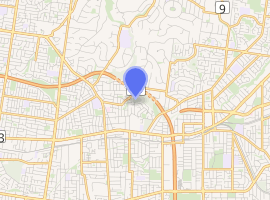Yarran Dheran
Yarran Dheran is an important riparian bushland park, located in the outer eastern suburbs of Melbourne in Mitcham on the border of Donvale, on the banks of the Mullum Mullum Creek. The park comprises 7.2 hectares and hosts a mix of remnant and regenerative bushland, and many native species of wildlife, particularly birds, of which there are over 85 species living in the park. The Mullum Mullum Creek Trail runs through the park and there are many small unsealed bush tracks through the native bushland. There is a visitors centre near the middle of the park, toilets and many mown grassed areas for picnics and seating.
| Yarran Dheran | |
|---|---|
The Mullum Mullum Creek running through Yarran Dheran | |

| |
| Type | Public Park |
| Location | Melbourne, Australia |
| Coordinates | 37°48′27″S 145°12′16″E |
| Area | 7.2 hectares |
| Operated by | City of Whitehorse |
| Status | Open |
| Paths | Mullum Mullum Creek Trail, Unsealed bush paths |
| Terrain | Remnant and regenerated riparian Bushland |
| Water | Mullum Mullum Creek and various gullies |
| Vegetation | Eucalypts, Acacias, River Red Gums |
| Connecting transport | Car, Bus (nearby) |
| Landmarks | Mullum Mullum Creek |
| Facilities | Visitors Centre, Toilets, Picnic areas [1] |
History
In 1865 August Schwerkolt built a cottage for his family from stone taken from the Mullum Mullum Creek about 2 kilometres upstream from what is now Yarran Dheran. A bullock track was cut along the banks of the creek for carting stone which extended as far as the crown land which was set aside for a stone quarry which occupied a large part of the park. In later years, a private contractor and the Nunawading Council worked the quarry until 1963 when the Council operated a tip in the old quarry. The 1962 Melbourne bushfires destroyed part of the natural vegetation and also a pine plantation planted in the 1930s by Mitcham Primary School. In 1967 it was declared that the crown land would be the site for a public park.
Following presentations from the local residents and the Blackburn Tree Preservation Society, the site was chosen for a native plant park and the name Yarran Dheran, roughly meaning Wattle Gully, was chosen. In April 1971 a committee of management was established and over 40,000 trees and shrubs were planted over the following 10 years. In 1973 a landscape designer was appointed to prepare a master plan and two hectares of additional land was purchased, increasing the size of the park to 7.2 hectares. In 1975 major earthworks began, a waterfall and fern gully were completed in 1979 and the information centre in 1980.[2]
Some residents saw the construction of the wider pathway and new bridges for the Mullum Mullum Creek Trail as negative for the park in general, as before these new construction works, the park hosted many obscure winding unsealed bush paths through which visitors could wander. The completion of the new trail pathways and bridges has given a quicker and easier through route through the park for cyclists.
Flora and fauna
Yarran Dheran features wattles such as silver wattle (Acacia dealbata) and blackwood (A. melanoxylon), and wattles that flower during spring such as prickly Moses (A. verticillata) and black wattle (A. mearnsii). A number of species of orchids can be found in Yarran Dheran, including wax-lip orchid (Glassodia major), Bluebeard Caladenia (Pheladenia deformis), and the spider orchid. The creeper purple coral-pea (Hardenbergia violacea) which was once prevalent throughout the surrounding hills, to the extent that they were known as the purple hills, can also be found around the park.
There are over 85 species of birds in Yarran Dheran, including Australian magpies, grey fantail, the noisy miner, the Eastern yellow robin and the Eastern silvereyes. Many birds use plastics washed down the creek as one of many materials to build their nests. Koala sightings are sometimes reported by residents in the surrounding area and are occasionally added to notice boards in the park.[3] Visitors are warned that in the spring, magpies swoop both humans and wildlife which they consider a threat to their nests, such as koalas. Snakes may also be encountered by visitors. Dogs are required to remain on leads at all times[1] as there are echidnas in the park and dogs off leads pose a threat to these animals.
References
- Melways Edition 36, 2009
- Yarran Dheran - History, retrieved 27 March 2011
- Yarran Dheran visitor information centre